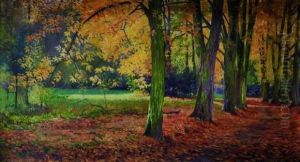Paul Armand Girardet Paintings
Paul Armand Girardet was a Swiss-born French engraver and painter, known for his landscape and orientalist works. He was born on March 25, 1821, in Le Locle, Neuchâtel, Switzerland, into a family with a rich artistic tradition. His father, Samuel Girardet, was a respected engraver, and his brothers, Jules, Edouard, and Théodore, were also accomplished artists. This environment nurtured his artistic talents from a young age.
Girardet initially trained under his father and then moved to Paris to further his education. In Paris, he studied engraving and became proficient in the art, contributing to various publications and producing works that were widely appreciated for their detail and artistic quality. Throughout his career, Girardet exhibited his works at the Paris Salon and other exhibitions, earning recognition and medals for his contributions to art.
He traveled extensively in Europe and North Africa, drawing inspiration from the diverse landscapes and cultures he encountered. These travels influenced his artistic style, which often depicted exotic and pastoral scenes with meticulous attention to detail and a vivid sense of realism. In addition to landscapes, Girardet's oeuvre includes historical scenes and genre paintings, reflecting the romantic and picturesque sensibilities of the 19th century.
Paul Armand Girardet's work was part of the 19th-century movement that saw French artists exploring and romanticizing the 'Orient'—the regions of the Middle East and North Africa. This orientalist trend was prevalent among many European artists of the time, who were fascinated by the exotic and unfamiliar aspects of these distant lands.
Girardet passed away on April 28, 1893, in Versailles, France. His legacy is preserved in the form of his works, which are held in various collections and museums around the world. His contributions to the field of engraving and painting remain valued for their technical proficiency and the window they provide into the romantic imagination of the 19th century.
